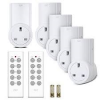Hello,
I have a couple of 10w LED outdoor spotlights to install and will control them from a remote through a RF socket - the socket adaptors that plug into the wall socket.
Question is can I / should I break into he lighting ring in the loft and put a wall socket in?
Or should I be running a spur from the socket ring? (more difficult to run the cable to the loft).
I've simply never seen a wall socket in a lighting ring, but because I want to use the RF remote to turn the lights on and off, I have to 'plug' the LED light in....
thanks
I have a couple of 10w LED outdoor spotlights to install and will control them from a remote through a RF socket - the socket adaptors that plug into the wall socket.
Question is can I / should I break into he lighting ring in the loft and put a wall socket in?
Or should I be running a spur from the socket ring? (more difficult to run the cable to the loft).
I've simply never seen a wall socket in a lighting ring, but because I want to use the RF remote to turn the lights on and off, I have to 'plug' the LED light in....
thanks


